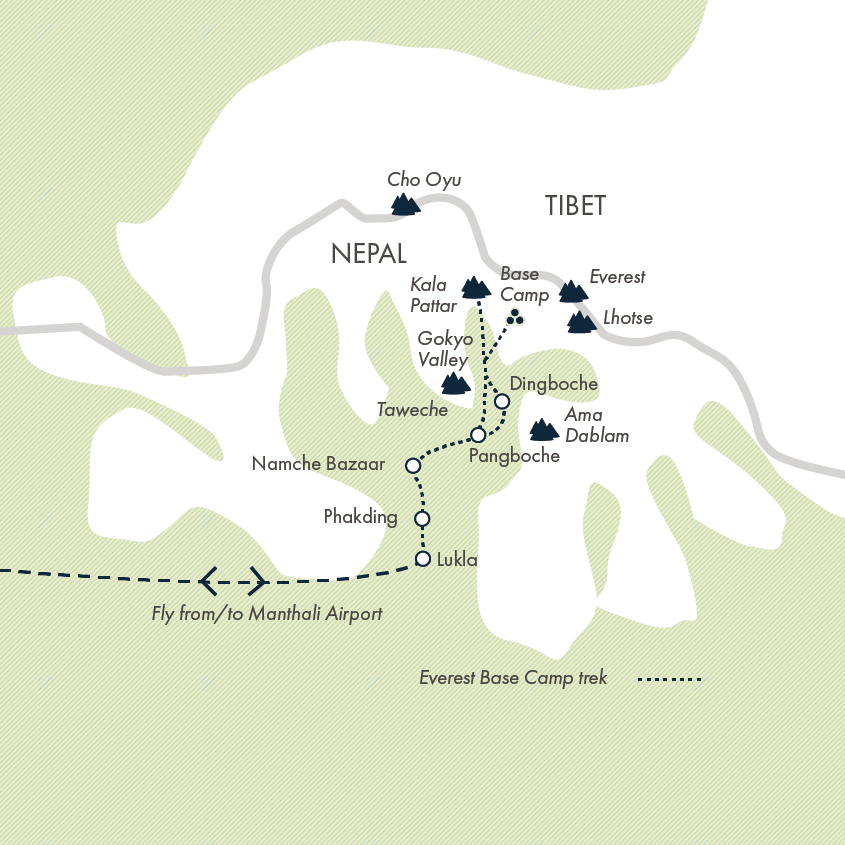- Key Info
- Overview
- Photos
- Dates

- Walk the classic route to Everest Base Camp, a legendary trail
- See the Khumbu Icefall from Everest Base Camp and take a picture at the Base Camp rock
- Ascend Kala Pattar for unforgettable views of Mount Everest
- Explore the bustling Namche Bazaar to soak up Sherpa culture
- Visit the hilltop monastery at Thyangboche
- Visit Sagarmatha Next and support the effort to keep Everest’s trails trash free
We stay in teahouses for most of this trip but start and end in the comfort of a locally run hotel within walking distance of the buzzy Thamel district, a prime location to many amenities.
Hotel Royal Singi, Kathmandu
The Hotel Royal Singi, a three-star hotel, has been welcoming Exodus travellers for more than two decades. The name is inspired by the Snow Lion, a mythical creature in Tibetan Buddhism, which symbolises immense joy, positivity, delight and comfort. The hotel embraces the name with a restaurant, bar, outdoor courtyard, and complimentary wifi throughout. There's also an Exodus desk in the lobby and an Exodus representative is usually available daily in the mornings and evenings. The Royal Singi is well located near the Thamel district, close to banks, restaurants, shops and attractions.
Teahouses in the Everest region
Staying in teahouses is a time-honoured tradition for expeditions to Everest Base Camp and, in fact, most hiking trips within the Himalaya. They may be basic, but teahouses become a welcome sight after a day of hiking through the region. The hub of teahouse living is the dining room, which is usually decorated with colourful, traditional rugs, sometimes with a stove or heater (some lodges charge a fee to put the heater on). Most teahouses sell snacks and other essentials such as tissues, soap and toilet paper.
We stay in twin-share bedrooms, which come with foam mattresses, bedsheets and a pillow. Remember to bring (or hire) a sleeping bag, rooms are unheated so can get cold at night.
Below are a couple of the teahouses we typically use en route.
Green Tara Hotel, Namche Bazaar
The Green Tara Hotel is one of our most popular teahouses on the Everest trail, offering cosy accommodation and warm hospitality. The comforts of a hot shower, delicious Sherpa cuisine and a snug dining space allow you to relax during your stay. The restaurant, wifi, charging ports and warm lounge enhance your experience, while the breathtaking views of Namche Bazaar and Himalaya mountains certainly leave a lasting memory.
Ama Dablam Lodge
One of our most-liked lodges in the Everest region, with an amazing view to Ama Dablam (we usually have breakfast on the terrace looking across to this beautiful mountain). You will also enjoy true Sherpa hospitality here thanks to Tashi Sherpa and her family. Tashi also runs a bakery, so make sure you try her famous fresh apple pie and homemade cookies.
Worth knowing
Some teahouses above 9,845ft (3,000m) may not be heated due to local environmental restrictions. Occasionally, kerosene burners can be used to heat common areas if requested. We recommend against using these due to the risk of carbon monoxide poisoning. Your leader will not offer this to you.
Almost all teahouses have electricity, but it is not wholly reliable and lighting may not be bright enough to read by – a torch (flashlight) is essential. Charging facilities are generally only available in the dining room (charged at approximately 200-500 Nepalese rupees/US$1.50-US$3.80 per hour per device). Many of the lodges use solar power, so sometimes there is not enough electricity for charging. Many lodges have wifi, though it can be slow and temperamental.
Most lodges have only one or two basic toilets and sometimes these are outside the main building. Toilets are usually squat-style, although many lodges have now installed seated ones. Toilet paper is not provided, so you should bring your own or buy it locally (please dispose of it in the bin provided). If there is not a flush handle, there should be a container of water to pour down – if it is empty (or frozen), please refill it or ask the lodge to.
Some lodges have hot ‘showers’ (charged at approximately 250-500 rupees/US$1.90-US$3.80 per shower). Sometimes this is simply a bucket of hot water.
Standards of cleanliness vary, especially in the peak trekking season and in winter when the water freezes at night. Please report any problems to your leader or the lodge and be vigilant in your personal hygiene regime – use soap or hand sanitiser gel before and after toilet breaks, snacks and mealtimes.
Generally, the higher the altitude, the more basic the lodges and the more expensive food and services.
Extra accommodation
If you require additional accommodation in Kathmandu, either before or after the tour, we can book this for you (subject to availability). Please enquire with your sales representative.
Single accommodation
If you prefer your own room, we offer a single supplement for the hotel nights in Kathmandu only (subject to availability). While in the teahouses, single rooms cannot be guaranteed so these have not been included in the single supplement price paid in advance. However, if a single room is available on arrival to a tea-house, you can pay locally on a day-by-day basis.